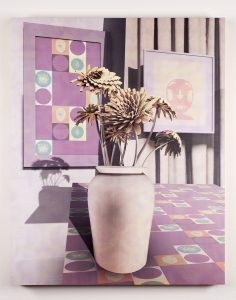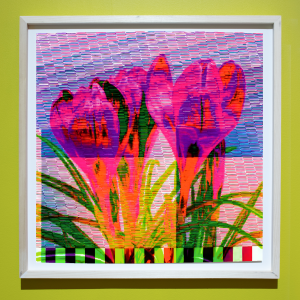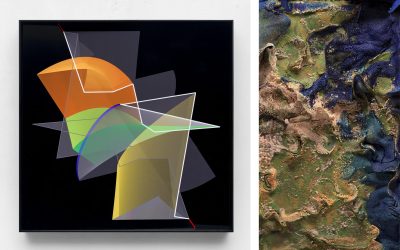Beginning as an action painter and a jazz musician in Europe, Manfred Mohr became increasingly detached from spontaneous expression and turned to a more systematic, geometric expression. It was the influence of French composer Pierre Barbaud and German Philosopher Max Bense that pointed him to a rational construction of art through the use of computational algorithms. Since 1968, Manfred Mohr has used the computer to generate his art.
MANFRED MOHR
space.color.motion
SHOW DATES: 12 05 02 – 1 11 03 OPENING RECEPTION: 12 07 02, 6-8PM
Beginning as an action painter and a jazz musician in Europe, Manfred Mohr became increasingly detached from spontaneous expression and turned to a more systematic, geometric expression. It was the influence of French composer Pierre Barbaud and German Philosopher Max Bense that pointed him to a rational construction of art through the use of computational algorithms. Since 1968, Manfred Mohr has used the computer to generate his art.
In 1971, he had a one-man show at the Museum of Modern Art in Paris, France, which became the historic “first” one-man show in a museum of works entirely calculated and drawn by a computer. Mohr’s work can be found in the Centre Pompidou in Paris, the Joseph Albers Museum in Bottrop, the Ludwig Museum in Cologne and numerous other museums and collections. Since 1973, Mohr has been concentrating on fracturing the symmetry of a cube (including since 1978 n-dimensional hypercubes), using the structure of the cube as a “system” and “alphabet”. The disturbance or disintegration of symmetry is the basic generator of new constructions and relationships.
space.color.motion
space refers to Mohr’s black and white – binary works based on the fracturing of a cube’s symmetry in cartesian coordinates. color, a recent, bold move for Mohr after 35 years of black and white only art, includes works based on the 6 dimensional hypercube. Color is used as random elements to describe spacial relationships. motion is Mohr’s new presentations in animation and movement of the system of binary decisions. Displayed in handmade computer stations and flat screens, these works, generated from programs written by Mohr, offer a subtle pace – a revealing view into the thought process of Mohr’s creations.
According to Lauren Sedofsky, “Mohr’s highly abstract, multi-dimensional “graphic entities” serve the very salutary purpose of repositioning the issue of “binary” art within the concerns and aspirations typically associated with Constructivism. The abstraction involved – the creation of an autonomous formalized universe whose inherent possibilities become accessible to exhaustive exploration – connects obliquely, but pertinently with the current scientific practice of modeling and visualizing theoretical systems.” 1
Manfred Mohr was born in Pforzheim, Germany. After residing in Paris for many years, he has lived in New York City since 1981. His awards include a Golden Nica from Ars Electronica/Linz, Camille Graeser Prize in Zürich, and the Biennial in Ljubljana. After a monograph on his work was published by Waser-Verlag in 1994, he received an Artists’ Fellowship from New York Foundation for the Arts. He recently had several solo shows in Europe including; the “Museum of Concrete Art” in Ingolstadt/Germany, “Wilhelm-Hack-Museum” in Ludwigshafen/Germany, and the “Schoeller Gallery” in Dusseldorf/Germany.
—
1. Catalog essay for Manfred Mohr’s show at the Josef Albers Museum (Bottrop, Germany)


